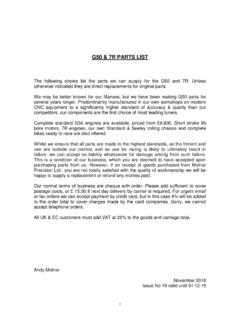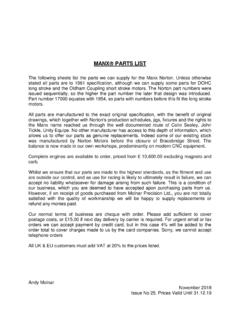Transcription of ERKS - Oil-Seals - Sealing technology Handbook
1 Oil Sealssealing technology +31 72 514 15 72 514 18 and finished products of:Eriflon-PTFE - PVDF - PCTFEE rtalon - PA6 and PA66 Ertacetal - POME rtalyte - PETPN ylatronFluorosintTorlonTechtronPEEK/PSU/ PEIM eldin-PITrovidur/Epradur PVCM ultilene PE and PPpolycarbonateacrylate - PMMA - PETE pratex/Tufnol-PF (laminated fabric)Hapa - PF (laminated paper)RX Grate/GVK (glass-fibrereinforced plastics)Erlan/Rhino Hyde -PURS hould you need a product youcannot find on this page, pleasecall one of our ERIKS Servicecenters (see on the back of this cover).+31 72 514 18 and fittings of.
2 - Superflo ABS- Air-Line Xtra- PE- PP- PVC- PVC-C- PVDF ball valvesdiaphragm valvesbutterfly valvesglobe valvescheck valvesstrainersoverflow valvesreducing valvessolenoid valvesclampstoolscementsplastic tankswall sleevesrepair clampsoil sealsEri-sleeves shaft protectingV-ringsPS sealsseals, guide parts and wipers for hydraulic and pneumatic cylindersMultisealsOmniseals spring actuatedPTFE sealsend capsKVSP Kalrez valve stempackingslubricantsgreasesleak detection spraysliquid sealants+31 72 514 18 72 514 18 72 514 18 vormartikelen rubber moulded partsprofiles of:- cellular rubber- sponge rubber- solid rubberinflatable sealsO-ringsX-ringsback-up ringscordsadhesivesboxes of assorted O-ringsvibration absorbershoses of:- rubber- plastic- PTFE- metalhose couplingscoupling systemshose clampshose reelshose reel cartshydraulic hosesfittings and couplings forhydraulicsexpansion joints of:- rubber- metal- fabric- PTFE metallic and semi-metallic gaskets:- spiral wound- ring type joint- serrated- insulating setsflange gaskets and die-cut parts of.
3 - elastomers- fibre sheet- PTFE sheet/tape- graphite sheetstuffing-box packingsmechanical sealsklepafsluitersglobe valvesgate valvescheck valvesstrainerssight glassessteam trapsreducing valvessafety valvesgauge glassesoverflow valvesvacuum and air reliefe valvesball valvesbutterfly valvespneumatic and electricactuatorsdiaphragm valvespinch valvesmeasurement and regulationcomponents for: - pressure- temperature- flow- levelcontrol valvessolenoid valves+31 72 514 18 accessible dia direct phone numbersYou can also consult ourOnline-Catalog with over45,000 products in +31 72 514 18 pipinghosEs, accEssoriEsand Expansion jointsindustrial plasticsvalvEs and instrumEntationFlangEgasKEts, mEchanical sEals and pacKingsdynamicsEalso-rings &tEchnical rubbErgEnEraloil sealsERIKS bvPO Box 280NL-1800 BK AlkmaarT +31 72 514 15 14F +31 72 515 56 SEALS 2 ContentsERIKS OIL SEALS TECHNICAL MANUAL1.
4 Introduction ..32. Description and principle of Oil Seals ..43. Construction of Oil Seals ..54. Common types ..65. Common materials ..116. Shaft materials, seal tolerance and housing ..147. Shaft eccentricity and shaft runout ..158. Materials and tolerances of the shaft ..169. Lubrication ..1710. Oil Seals for higher pressures ..1811. Split Oil Seals ..1912. Assembly of the Oil Seal ..2113. Troubleshooting ..2314. Conversion table inch / mm ..2415. Table of DIN dimensions ..25 DisclaimerThe information provided in this document is for general information purposes only and does not constitute advice.
5 ERIKS shall not be liable for any damages resulting from the use of this document, including but not limited to damages caused by any incorrectness or incompleteness of the provided information, unless such damage is the result of any wilful misconduct or gross negligence on part of SEALS 31. Introduction ERIKS is known worldwide for its comprehensive range of seals including O-rings, rotary shaft seals, hydraulic and pump seals. Since 1960, ERIKS have developed this range to include the following product lines:NBR Oil Seals in all standard types and sizes Viton Oil Seals type GR and GRST, fully encapsulatedOil Seals of rubber/textile construction for heavy duty applicationsOil Seals in non standard rubber compounds such as EPDM, XNBR, HNBR, Silicone, PTFE lip seals and PS Seals Oil Seals for higher pressures: VR Oil Seals End caps V-seals Alpha seals In this documentation you will find the most relevant technical information regarding Oil Seals.
6 ERIKS has 9000 moulds to produce these standard Oil Seals as well as the production facilities to produce small quantities of non standard Oil will be pleased to give you the information you need. You will be surprised by our keen prices!OIL SEALS 42. Principle of Oil Seals Oil SealsOne of the most frequently used types of seal is the Rotary Shaft Seal. This is generally used for Sealing lubricating oil or grease in rotary shaft applications. In exceptional cases, it is also used to seal other fluids, gases and powdered or granular solids. For trouble-free operation and optimum service life of a seal, shafts must have a satisfactory surface finish, within recommended limits and have no machine lay.
7 Both correct design and material choice are critical if bearings and gears are to be sealed to prevent the leakage of lubricating oils and greases and the ingress of penetrating dust and good lubricating oil forms a strong tenacious film on gears, bearings and shafts and is not easily removed from the pressure bearing surfaces of these. However, where the shaft extends away from the equipment, this oil film must be retained. In Oil Seals, the pressure or radial load exerted by the Sealing lip must be sufficient to retain the oil film, whilst not so high that excessive friction losses or wear can occur.
8 Good Oil Seal design is therefore a balance between optimum running properties of the material, lip design and integral garter spring. Working principleDuring rotation of the shaft, a hydrodynamic film of lubricant is produced beneath the Sealing lip, the thickness of which depends on shaft speed, oil temperature, oil viscosity and the pressure or radial load exerted by the Sealing lip on the shaft. Due to capillary forces and the surface topography of the shaft, the fluid being sealed forms a meniscus under the Sealing lip and is prevented from leaking. The fluid, the seal material, the film thickness, the Sealing lip geometry and the surface topography of the shaft are governing factors in the realisation of these capillary forces.
9 A used seal having a shiny wear flat with hardening and radial cracking is indicative that it had operated on a shaft which was too smooth and /or that the radial load exerted by the lip was too high. A used seal having a wide wear flat is indicative that it had operated on a shaft which was too rough, especially if there was no hardening or radial cracking and could also be associated with incorrect Sealing lip SEALS 53. Construction of the oil seal DIN 3760/3761 DIN 3760/3761 describes the standardisation of design, dimensions and tolerances of Oil Standard 3760 ERIKS TYPEARUBBER COVEREDRASAS TYPE A WITH DUST LIPRSTBMETAL CASED DESIGNMBSAS TYPE B WITH DUSTLIPMSTCDOUBLE METAL CASEDGVCSAS TYPE C WITH DUST LIPGVSTTYPE RThe most commonly used type is type R.
10 This type has a carbon steel insert and has rubber outside diameter. The rubber gives a good Sealing capability, even when the housing is not fully in tolerance. The Sealing lip with spring provides interference on the shaft for effective Sealing . The outside diameter, with inner metal reinforcement case, allows press-fitting in the housing, with sufficient interference on the rubber to provide static Sealing . The Sealing element is produced from a high performance Nitrile rubber. This in combination with a high quality galvanised steel garter spring gives the ERIKS Oil Seal an optimum life.






